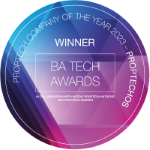Introduction [00:00:26]
Dr. Erik Wallin: Welcome to Best of Breeds, a podcast by ProptechOS. Today, I’m joined by John Wibrand from Swegon. His LinkedIn title is HVAC Director of Digital, but John, I’ve known you for quite a few years now, and I’d say you’re more of an IoT enthusiast and veteran entrepreneur with a technical physics background. Today, we’re diving into the question, “How hard can ventilation really be?” But first, John, could you give us a bit of background on the Swegon Group? Where in the world are you active, and what areas do you focus on?
John Wibrand: Swegon is a fairly large company with around 4,000 employees and growing. We have about 25 factories—most in Europe, three in Sweden, plus some in India, one in Canada, and a couple in the U.S. We’re focused on HVAC—heating, ventilation, and air conditioning. This includes manufacturing air-handling units, demand-controlled ventilation, heat pumps, and cooling machines. Our goal is to integrate systems for maximum energy efficiency while maintaining good indoor environmental quality.
Smart Building Project Case Study [00:01:26]
Dr. Erik Wallin: We’ve collaborated on a few projects, one of which involved a high-demand smart building system for an 800,000-square-foot, 1,000-room building. You received an RSA for this sophisticated project, correct?
John Wibrand: Yes, they asked us to deliver certain functionalities for their specific use cases. We could provide some of them, but for others, our system wasn’t initially set up. For example, our systems measure indoor metrics like temperature and CO₂ levels but don’t account for external factors. They wanted energy control based on electricity prices, which reminded me of your expertise. So, we arranged a joint meeting with the client to tackle it together.
Dr. Erik Wallin: That’s a prime example of ecosystem thinking—you can’t be an expert in everything. Since Swegon was already using Brick Schema and RealEstateCore, the integration was fairly smooth. Speaking of ventilation systems, how hard can it really be? You have fans, heating, cooling, and some simple PID regulators, right?
John Wibrand: It’s surprisingly complex. Each component—fan blades, motors, sensors, duct systems, filters—has specialists working on it. Even the fan blades alone are critical, with dedicated design teams. And let’s not forget software—it’s increasingly important in optimizing systems.
Complexity of Ventilation Systems [00:04:26]
Dr. Erik Wallin: One impressive aspect of this project was validating the systems. After analyzing room usage, we found almost 30% energy savings simply by optimizing configurations. Was this not done initially?
John Wibrand: Often, systems aren’t set up perfectly, or configurations change over time. In this case, presence detection wasn’t activated, causing unnecessary airflow at times. When we asked the client, they agreed to activate it, resulting in significant savings. Correct configuration can save energy with minimal investment.
Dr. Erik Wallin: Absolutely, and combining this with presence data further confirmed low occupancy during certain hours, allowing us to reduce airflow. It’s a simple, low-cost improvement with immediate benefits.
John Wibrand: Exactly. And transparency with tenants about indoor conditions adds value. Allowing temperature adjustments and feedback options gives them control and can reduce energy usage.
Vacation Mode and Energy Management [00:07:26]
Dr. Erik Wallin: One feature we added was “vacation mode,” which lets tenants set buildings to a lower energy state. Could you explain how that works?
John Wibrand: With vacation mode, parts of the building can adjust to slightly warmer or cooler settings based on external signals, like electricity prices. Even a one-degree temperature drift can save energy without tenants noticing, especially in well-insulated buildings.
Dr. Erik Wallin: And tenants appreciate this feature—it allows them to contribute to energy savings, similar to adjusting thermostats at home.
Balancing Energy and Indoor Quality [00:10:26]
Dr. Erik Wallin: With rising energy prices and sustainability requirements, balancing energy savings with indoor quality is crucial. Do you find these goals conflicting?
John Wibrand: Not necessarily. Improving indoor environmental quality and saving energy often go hand-in-hand. Buildings are made for people, and ensuring comfort and productivity is essential. Energy efficiency should enhance, not compromise, the indoor experience.
Dr. Erik Wallin: AI is often touted as the ultimate solution. Do you foresee self-configuring HVAC systems?
John Wibrand: That’s the dream, but it all hinges on high-quality data. AI functionality exists in our systems, but to scale, data must be consistent and reliable across buildings.
System Maintenance and Future Considerations [00:12:26]
Dr. Erik Wallin: Standardized data formats like RealEstateCore and Brick Schema are critical for this. But with thousands of sensors, some will inevitably malfunction. How do you handle this?
John Wibrand: Prioritization is key. Complex buildings require focus on what truly impacts performance, while keeping systems understandable. Documentation is crucial so that future teams can maintain configurations effectively.
Conclusion [00:14:26]
Dr. Erik Wallin: It’s a collaborative effort. Integration between systems is mandated by EU energy regulations, and I agree with your focus on keeping it simple and effective.
John Wibrand: Exactly. Collaboration between property owners, product providers, and tech firms is essential for robust, flexible systems.
Dr. Erik Wallin: To wrap up, my takeaways are: validate configurations, keep systems interoperable, and focus on ease of integration. John, thank you for this enlightening discussion. Follow John and this podcast through the links provided, and please subscribe to Best of Breeds by ProptechOS.
